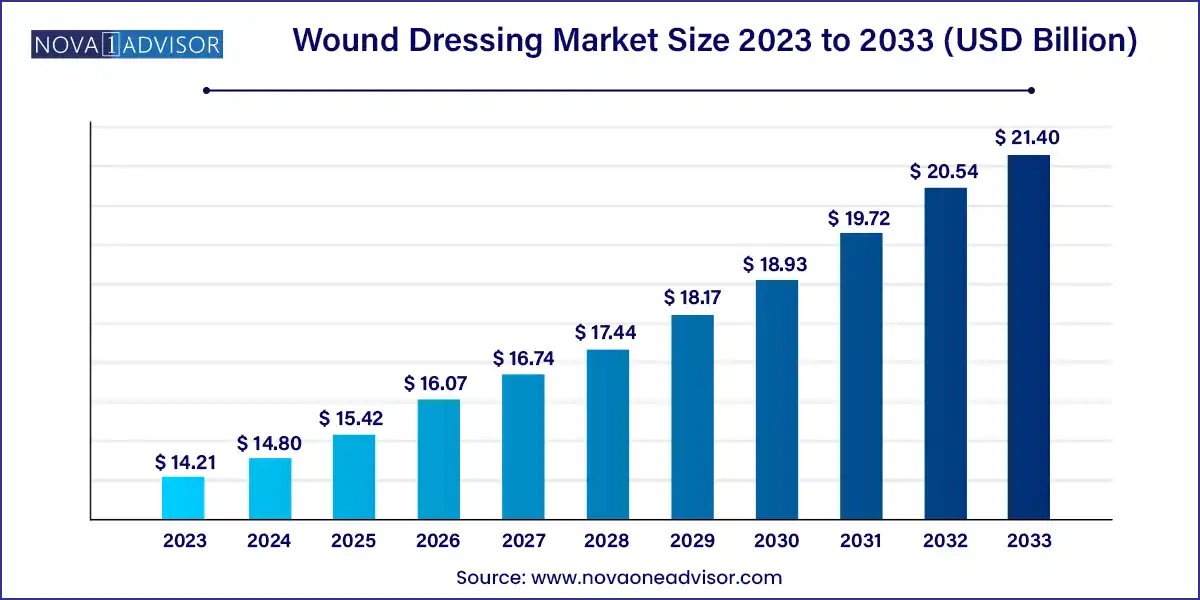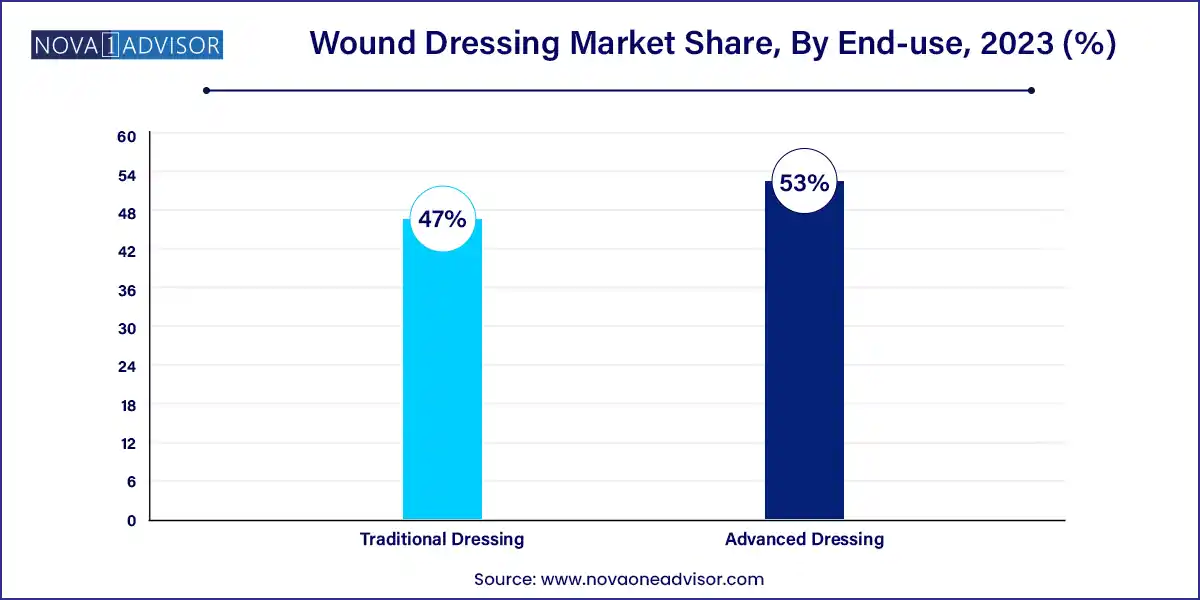The global wound dressing market size was exhibited at USD 14.21 billion in 2023 and is projected to hit around USD 21.40 billion by 2033, growing at a CAGR of 4.18% during the forecast period of 2024 to 2033.

Key Takeaways:
- North America dominated the market with a revenue share of 46.0% in 2023.
- Advanced dressing led the market and accounted for a revenue share of 53.0% in 2023.
- The chronic wounds segment dominated the market in 2023.
- The hospital segment dominated the market in 2023.
Market Overview
The wound dressing market has evolved significantly from traditional materials like cotton and gauze to sophisticated, bioactive products tailored to specific wound types and healing stages. Wound dressings are critical components in wound management, designed not only to protect the wound but also to facilitate faster healing, reduce pain, and prevent infections. They are used across a broad spectrum of clinical scenarios, including surgical interventions, trauma cases, chronic wound management, and burn care.
Aging populations, rising surgical procedures, and the increasing prevalence of lifestyle-related chronic wounds such as diabetic foot ulcers and pressure ulcers are major contributors to market demand. Additionally, advancements in material sciences and biomedical engineering have led to the development of dressings that maintain optimal moisture balance, deliver drugs locally, and even integrate antimicrobial or oxygen-enhancing capabilities.
As the burden of chronic wounds grows worldwide and healthcare systems seek cost-effective yet high-performance solutions, the wound dressing market is gaining prominence. Globally, health organizations are emphasizing early wound care, and public-private collaborations are funding innovations in wound management technologies, boosting market expansion.
Major Trends in the Market
-
Rising Preference for Moist and Advanced Dressings: Foam, hydrocolloid, and hydrogel dressings are gaining traction due to their superior healing properties.
-
Integration of Antimicrobial Agents: Silver-based and non-silver antimicrobial dressings are being adopted to reduce infection risks, particularly in chronic wounds.
-
Shift Toward Bioactive and Skin-Substitute Dressings: Innovations in active dressings support tissue regeneration and wound closure.
-
Growing Use of Smart and Oxygen-Releasing Dressings: Technologies offering pH monitoring or micro-oxygenation are entering the market.
-
Increased Demand in Home Healthcare: The rise in home-based care is driving demand for easy-to-apply and longer-wear dressings.
-
Eco-Friendly and Biodegradable Products: Sustainable materials are being explored to reduce clinical waste and environmental impact.
-
Digital Tracking and e-Wound Platforms: Clinical use of mobile apps for dressing change schedules and wound documentation is rising.
-
Strong Growth in Emerging Economies: Governments are funding wound care access through universal health schemes and rural outreach.
Wound Dressing Market Report Scope
| Report Coverage |
Details |
| Market Size in 2024 |
USD 14.80 Billion |
| Market Size by 2033 |
USD 21.40 Billion |
| Growth Rate From 2024 to 2033 |
CAGR of 4.18% |
| Base Year |
2023 |
| Forecast Period |
2024-2033 |
| Segments Covered |
Product, Application, End-use, Region |
| Market Analysis (Terms Used) |
Value (US$ Million/Billion) or (Volume/Units) |
| Regional Scope |
North America; Europe; Asia Pacific; Central and South America; the Middle East and Africa |
| Key Companies Profiled |
3M; Coloplast Corp.; Medline Industries; Smith & Nephew; ConvaTec Group PLC; Derma Sciences (Integra LifeSciences); Ethicon (Johnson & Johnson); Baxter International; Molnlycke Health Care AB |
Market Driver: Increasing Burden of Chronic Wounds and Surgeries
One of the most significant drivers of the wound dressing market is the global rise in chronic wounds, particularly driven by conditions like diabetes, vascular disease, and immobility-related pressure ulcers. Diabetic foot ulcers alone affect over 15% of diabetics globally and are associated with high morbidity and healthcare costs.
Simultaneously, an increase in the volume of surgical procedures due to growing life expectancy and medical accessibility has expanded the need for post-operative wound care. Proper dressing is essential to prevent infection and complications, ensuring faster recovery and shorter hospital stays. Advanced wound dressings are being increasingly adopted in surgical units for their ability to create a moist healing environment, which accelerates tissue repair.
Market Restraint: High Cost of Advanced Wound Dressings
Despite their clinical benefits, the high cost of advanced and active wound dressings is a notable barrier to wider adoption, particularly in low- and middle-income countries. Advanced dressings can be several times more expensive than traditional gauze or cotton, and in many healthcare systems, they are not fully reimbursed.
This cost barrier limits the use of advanced products in outpatient or primary care settings where budgets are constrained. Additionally, in homecare environments, patients may default to cheaper alternatives due to affordability issues, even when clinical guidance favors advanced solutions. This cost-benefit mismatch affects market penetration and remains a concern for both manufacturers and healthcare policymakers.
Market Opportunity: Expansion into Home Healthcare and Remote Wound Management
With the shift toward value-based and patient-centric care, home-based wound management is emerging as a high-growth opportunity. Aging populations, rising demand for convenience, and post-COVID-19 emphasis on decentralized care have driven the need for wound dressing solutions that are easy to apply, monitor, and manage outside of clinical settings.
This is particularly relevant for patients with chronic wounds requiring long-term dressing. Companies are responding with adhesive foam dressings, antimicrobial sheets, and hydrocolloid plasters that require less frequent changes and can be used by non-clinicians. Furthermore, digital platforms are now being used to enable remote wound monitoring, where patients can upload images for clinical review creating a robust ecosystem for homecare wound management.
Segments Insights:
By Product Insights
Advanced wound dressings dominate the market, offering superior functionality such as moisture retention, antimicrobial protection, and autolytic debridement. Foam dressings, in particular, are widely used for both acute and chronic wounds due to their high absorbency and gentle contact layers. Hydrocolloid and hydrogel dressings are also gaining popularity, especially in pressure ulcers and burns, where maintaining a moist wound environment is essential.

Active dressings are the fastest-growing segment, led by biomaterial-based products and skin substitutes that actively promote healing. These include collagen-infused dressings and regenerative matrices used in complex wound scenarios such as diabetic foot ulcers and surgical wounds that fail to close. Demand for skin-substitutes is especially strong in burn centers and trauma units where full-thickness wounds are common.
By Application Insights
Chronic wounds dominate the market, with diabetic foot ulcers, venous leg ulcers, and pressure sores contributing a substantial share. These conditions often require prolonged and complex treatment protocols, where advanced dressings play a critical role. Silver dressings, alginates, and collagen-based products are frequently used in chronic cases to manage infection, exudate, and delayed granulation.
Acute wounds are witnessing faster growth, particularly driven by trauma cases, surgical site management, and burn injuries. As the global volume of surgeries rises—especially in orthopedic and cardiovascular domains—acute post-operative wound care has become more sophisticated. Single-use, long-wear foam and antimicrobial dressings are being adopted in operating rooms to reduce infection risk and improve healing outcomes.
By End-use Insights
Hospitals account for the largest market share, given their role in treating complex and surgical wounds. Hospital-based wound care units and surgical departments are significant consumers of advanced dressing products. Reimbursement coverage and bulk procurement models support adoption even for costlier dressings in these settings.
Home healthcare is the fastest-growing end-use segment, driven by long-term care of chronic wounds and palliative scenarios. Foam and hydrocolloid dressings designed for ease of application and extended wear time are well-suited for home use. Patients with mobility issues, the elderly, and those recovering post-surgery increasingly rely on homecare kits and telehealth support for wound care, accelerating this segment’s growth.
By Regional Insights
North America leads the global wound dressing market, fueled by a high prevalence of chronic diseases, robust healthcare infrastructure, and strong presence of key players. The U.S. is particularly active in wound care innovation and is supported by reimbursement systems that cover many advanced wound products. Clinical awareness and availability of homecare services further bolster demand.
Asia-Pacific is the fastest-growing region, led by rising healthcare expenditure, expanding hospital networks, and increasing surgical volumes. Countries such as China and India are witnessing rapid growth in diabetic populations, which is directly influencing the incidence of foot ulcers and skin lesions. Moreover, government healthcare schemes are beginning to cover advanced wound care, opening up opportunities for both local and global manufacturers.
Recent Developments
-
Smith & Nephew (April 2025): Launched the PICO 7Y single-use negative pressure dressing with an integrated canister for managing high-exudate wounds.
-
3M Health Care (March 2025): Announced FDA clearance for its Tegaderm™ CHG antimicrobial film dressing for use in post-surgical wounds.
-
Mölnlycke Health Care (February 2025): Expanded its Avance® Solo platform to include foam dressings with integrated oxygenation capabilities.
-
Convatec (January 2025): Partnered with an AI health tech company to develop a smart wound dressing sensor that monitors pH and exudate levels.
-
Coloplast (December 2024): Released biodegradable foam dressings made from plant-based polymers to reduce environmental impact in large hospital chains.
Some of the prominent players in the Wound dressing market include:
- Smith+Nephew
- Mölnlycke Health Care AB
- Convatec Group PLC
- Ethicon (Johnson & Johnson)
- Coloplast Corp.
- URGO
- Coloplast Corp.
- 3M
- Integra LifeSciences
- PAUL HARTMANN AG
- DR.AUSBÜTTEL (DRACO)
- Integra LifeSciences
- Medline Industries, Inc.
- Brightwake Ltd..
Segments Covered in the Report
This report forecasts revenue growth at global, regional, and country levels and provides an analysis of the latest industry trends in each of the sub-segments from 2021 to 2033. For this study, Nova one advisor, Inc. has segmented the global wound dressing market.
Product
-
- Gauze
- Tape
- Bandages
- Cotton
- Others
-
-
- Foam Dressing
- Hydrocolloid Dressing
- Film Dressing
- Alginate Dressing
- Hydrogel Dressing
- Collagen Dressing
- Other Advanced Dressing
-
-
- Silver Dressing
- Non-silver Dressing
-
-
- Biomaterials
- Skin-substitute
Application
-
- Diabetic Foot Ulcers
- Pressure Ulcers
- Venous Leg Ulcers
- Other Chronic Wounds
-
- Surgical & Traumatic Wounds
- Burns
End-use
- Hospitals
- Outpatient Facilities
- Home Healthcare
- Research & Manufacturing
By Region
- North America
- Europe
- Asia-Pacific
- Latin America
- Middle East & Africa (MEA)


